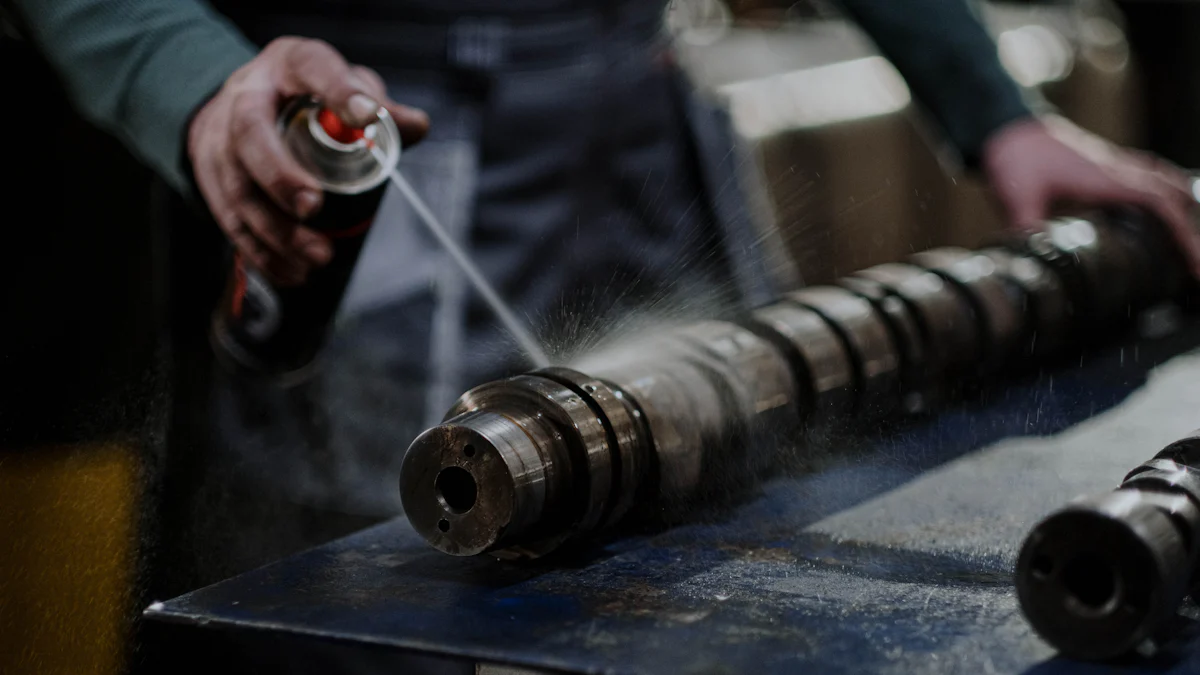
Welding cast iron exhaust manifolds can be tricky due to the high carbon content in cast iron, which makes it brittle, especially during the welding process. When working with performance harmonic balancers, excessive weld penetration can pull carbon into the weld, creating weak spots. To prevent cracking in both the intake manifold and exhaust manifold, welders must maintain ductility. Ningbo Werkwell, a trusted supplier of automotive parts, ensures quality in every product, including marine exhaust manifolds.
Challenges of Welding Cast Iron Exhaust Manifolds
Welding cast iron exhaust manifolds presents unique challenges that require careful planning and execution. Understanding these difficulties can help welders achieve better results and avoid common pitfalls.
Brittleness and High Carbon Content
Cast iron’s brittleness stems from its high carbon content, which typically ranges between 2% and 4%. This composition makes the material prone to cracking during welding. Rapid heating and cooling can worsen the problem, causing uneven heat distribution and creating hard, brittle zones in the weld. These areas are more likely to fail under stress. To minimize these risks, welders must use techniques that control heat and reduce thermal shock.
- The high carbon content increases the likelihood of cracking during the welding process.
- Rapid temperature changes can lead to weak welds and further damage.
Additionally, carbon migration during cooling can harden the weld, making it less ductile. This is why choosing the right filler material and welding method is crucial.
Thermal Sensitivity and Risk of Further Cracking
Cast iron’s low thermal conductivity makes it sensitive to temperature changes. Uneven heating can cause thermal stress, leading to new cracks or worsening existing ones. Welders often preheat the manifold to reduce this risk. Preheating ensures a more uniform temperature, which helps prevent sudden expansion or contraction during welding. Slow cooling after the process is equally important to avoid introducing new stress points.
Common challenges include:
- Managing thermal stress effectively.
- Implementing proper cooling techniques to prevent cracking.
- Dealing with unexpected damage during repairs.
Choosing the Right Welding Approach
Selecting the right welding method depends on the type of cast iron and the specific repair needs. For example, gray cast iron requires slow preheating and nickel electrodes, while nodular cast iron benefits from moderate preheating. Welders should also consider environmental factors, such as exposure to hot gases, which can affect the weld’s durability.
| Welding Method | Advantages | Disadvantages |
|---|---|---|
| SMAW | Adaptable and efficient for repairs. | Moderate cracking risks. |
| TIG | High accuracy, ideal for delicate work. | Not suitable for major repairs. |
| MIG | Faster for large repairs. | Moderate cracking risks. |
| Oxyacetylene | Useful for old parts and soft welds. | Low accuracy. |
| Brazing | Low cracking risks, good for fine repairs. | Not suitable for major structural repairs. |
Ningbo Werkwell, a specialized manufacturer in mechanical engineering, emphasizes quality in its automotive parts. Their expertise ensures reliable products, including exhaust manifolds, which benefit from advanced techniques and materials. Werkwell’s commitment to quality stems from their experienced QC team, which oversees every step, from die casting to chrome plating.
By understanding these challenges and choosing the right approach, welders can improve their chances of success when working with cast iron exhaust manifolds.
Preparing the Exhaust Manifold for Welding

Cleaning the Surface and Removing Contaminants
Before starting any welding work, cleaning the exhaust manifold is essential. A dirty surface can weaken the weld and lead to failure. Follow these steps to prepare the area properly:
- Bevel the Crack: Use a grinder to create a V-shaped groove along the crack. This groove allows the filler material to bond more effectively.
- Clean the Cast Iron: Remove all dirt, oil, and old metal from the surface. The area should look shiny and smooth before proceeding.
- Preheat the Manifold: Use a torch to warm up the manifold slightly. This step helps prevent thermal shock during the welding process.
A clean surface ensures a strong and durable weld, which is critical when repairing a welding cast iron exhaust manifold.
Drilling Holes to Prevent Crack Propagation
Drilling small holes at the ends of the crack is a simple but effective way to stop it from spreading. These holes act as “crack stoppers,” reducing stress concentration at the crack tips. Use a drill bit slightly larger than the crack width, and ensure the holes are clean and smooth. This step is especially important for brittle materials like cast iron, as it minimizes the risk of further damage during welding.
Dressing the Crack for Better Weld Penetration
Dressing the crack involves shaping and smoothing its edges to improve weld penetration. After beveling the crack, use a file or grinder to remove any sharp edges or irregularities. This process creates a uniform surface for the filler material to adhere to, resulting in a stronger bond. Proper dressing also reduces the chances of porosity in the weld, which can weaken the repair.
Preheating the Manifold to Reduce Thermal Stress
Preheating the exhaust manifold is crucial for reducing thermal stress during welding. Cast iron is highly sensitive to temperature changes, and sudden heating or cooling can cause cracks. The recommended preheating temperature range is between 200°C and 400°C (400°F and 750°F). Use a propane torch or an oven to heat the manifold evenly. Maintaining this temperature throughout the welding process ensures better results and minimizes the risk of new cracks forming.
Ningbo Werkwell, a specialized manufacturer in mechanical engineering, emphasizes quality in its automotive parts. Since 2015, the company has established a complete product line for automotive interior trim parts. Their experienced QC team ensures top-notch quality, from die casting to chrome plating. This commitment to excellence makes Werkwell a trusted name in the industry.
Welding Techniques for Cast Iron Exhaust Manifolds

Preheated Welding Method
Preheating is one of the most effective ways to weld a cast iron exhaust manifold. By heating the manifold to a temperature between 500°F and 1200°F, welders can reduce thermal stress and prevent cracks. The heat should be applied slowly and evenly across the entire casting to avoid uneven expansion. Preheating also minimizes the formation of hard, brittle structures in the weld zone and allows carbon to diffuse back into the base metal. This method relieves internal stresses, making the repair more durable and less prone to distortion.
Tip: Always monitor the temperature closely during preheating to ensure consistent results.
Non-Preheated Welding Method
Non-preheated welding is an alternative approach, but it comes with risks. Without preheating, the manifold remains cool, typically around 100°F. This can lead to rapid cooling after welding, increasing brittleness and the likelihood of cracks. Uneven heat distribution may also cause hard, brittle structures to form in the weld zone. Welders using this method must work carefully to minimize internal stresses and avoid carbon migration, which can weaken the repair.
- Risks of non-preheated welding:
- Higher chances of cracking due to rapid cooling.
- Uneven heat distribution causing structural weaknesses.
- Increased internal stress and distortion.
Using Nickel Rods for Better Results
Nickel rods are a popular choice for welding cast iron exhaust manifolds. Their high nickel content makes them more forgiving during the welding process. These rods can stretch as the weld cools, accommodating the different contraction rates of cast iron and steel. This flexibility reduces the risk of cracking and ensures a stronger bond. Nickel rods also handle carbon migration better, making them ideal for achieving a durable repair.
Note: Always choose high-quality nickel rods for the best results. They’re worth the investment for critical repairs.
Step-by-Step Welding Instructions
- Prepare the Manifold: Clean the damaged area thoroughly, bevel the crack to create a V-groove, and preheat the manifold if using the preheated method.
- Apply the Filler Material: Use a nickel rod or silver solder filler. Coat the crack with flux, deposit the filler evenly, and ensure proper adhesion.
- Cool the Manifold Slowly: Allow the manifold to cool gradually to prevent thermal shock and cracking.
- Inspect the Repair: Remove any residual flux and check the weld for strength and durability.
Ningbo Werkwell, a specialized manufacturer in mechanical engineering, emphasizes quality in its automotive parts. Since 2015, the company has offered a complete product line for automotive interior trim parts. Their experienced QC team ensures top-notch quality, from die casting to chrome plating. This commitment to excellence makes Werkwell a trusted name for reliable products like exhaust manifolds.
Post-Welding Care and Inspection
Peening to Relieve Stress
Peening is a crucial step after welding cast iron exhaust manifolds. It helps relieve stress in the welded areas, reducing the chances of cracking as the material cools. This process involves striking the weld surface while it’s still warm. A ball peen hammer is commonly used for this purpose. By gently tapping the surface, welders can compress the material, which helps distribute stress more evenly.
Tip: Be consistent with the force applied during peening to avoid creating weak spots.
Peening not only strengthens the weld but also ensures the repair lasts longer. It’s a simple yet effective way to improve the durability of the manifold.
Slow Cooling to Prevent Cracking
Cooling the manifold slowly after welding is just as important as the welding itself. Rapid cooling can introduce thermal stresses, leading to cracks or warping. To prevent this, welders should allow the manifold to cool gradually. Covering the work area with insulating materials, like a welding blanket, helps retain heat and ensures an even cooling rate. Protecting the manifold from wind or drafts is also essential, as uneven cooling can compromise the repair.
Note: Slow cooling is especially critical for cast iron due to its sensitivity to temperature changes.
By taking these precautions, welders can avoid undoing their hard work and ensure the manifold remains intact.
Inspecting the Weld for Durability and Strength
Once the manifold has cooled, inspecting the weld is the final step. Look for any visible cracks, porosity, or weak spots. A magnifying glass can help identify small imperfections. If the weld appears uneven or brittle, additional repairs may be necessary. Testing the manifold under light stress can also confirm its strength. A thorough inspection ensures the repair is reliable and ready for use.
Ningbo Werkwell is a specialized manufacturer and exporter in mechanical engineering. The company’s principal activity is supplying automotive parts and fasteners. Since 2015, Werkwell has offered a complete product line for automotive interior trim parts. Their experienced QC team ensures top-notch quality, from die casting and injection molding to chrome plating. This commitment to excellence makes Werkwell a trusted name in the industry.
Welding cast iron exhaust manifolds demands preparation, proper techniques, and post-welding care. Key steps include beveling cracks, cleaning surfaces, and preheating to prevent thermal shock. Avoiding mistakes like poor heat management ensures durability. Following best practices enhances performance and longevity. Ningbo Werkwell, a trusted supplier, guarantees quality automotive parts through expert QC processes since 2015.
FAQ
What makes welding cast iron exhaust manifolds so challenging?
Cast iron’s brittleness and high carbon content make it prone to cracking. Uneven heating or cooling adds stress, increasing the difficulty of achieving a durable repair.
Can I weld a cast iron manifold without preheating?
Yes, but it’s risky. Non-preheated welding increases the chances of cracks due to rapid cooling. Preheating ensures even heat distribution and reduces thermal stress.
Why is Ningbo Werkwell a trusted name in automotive parts?
Ningbo Werkwell specializes in mechanical engineering and automotive parts. Since 2015, their experienced QC team has ensured top-notch quality, from die casting to chrome plating.
Post time: Feb-17-2025



